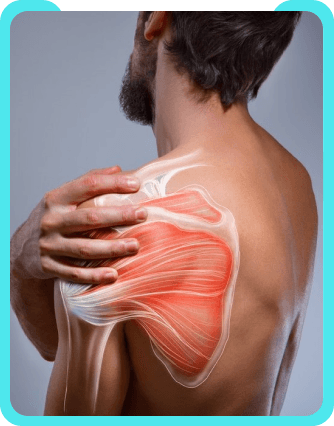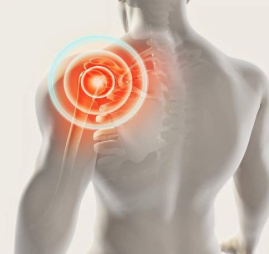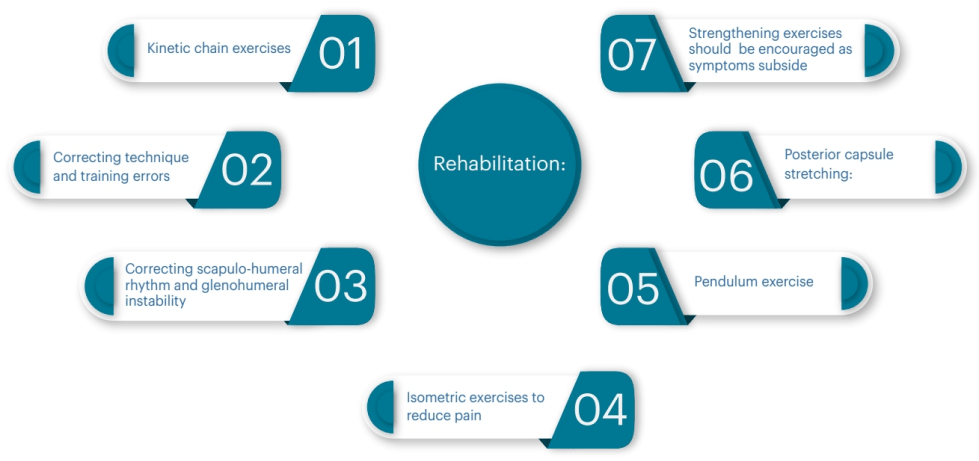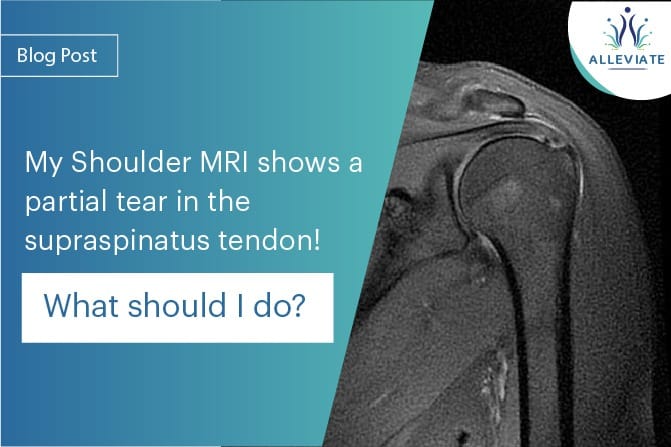
Rotator Cuff Injuries
- Home
- Conditions
- Shoulder pain
- Rotator Cuff Injuries
Rotator cuff tendonitis involves the tendons of the muscles forming the rotator cuff of the shoulder. As these muscles govern the movements of the shoulder joint, rotator cuff tendonitis is a very common cause of shoulder pain and weakness. Also referred to as impingement syndrome, some common daily activities like sleeping on one’s shoulder and engagement in daily overhead work can predispose individuals to rotator cuff tendonitis. Athletes involved in sports requiring overhead movements such as tennis, baseball are commonly involved. Hence this condition is also referred to as Swimmer’s shoulder and Pitcher’s shoulder.
Rotator Cuff Tendinopathy is an umbrella term encompassing the following conditions: “tendinitis, tendinosis, paratendinosis or partial tears of the Rotator Cuff tendons
Clinically Relevant Anatomy
The muscles arise from the scapula and connect to the head of the humours, forming a cuff at the glenohumeral joint
| Origin on Scapula | Insertion on Humerus | Primary Function | |
|---|---|---|---|
| Supraspinatus | Supraspinous Fossa | Superior Facet of Greater Tuberosity | Abduction |
| Infraspinatus | Infraspinous Fossa | Middle Facet of Greater Tuberosity | External Rotation |
| Teres Minor | Lateral Border of Scapula | Inferior Facet of Greater Tuberosity | External Rotation |
| Subscapularis | Subscapular Fossa Lesser | LesserTuberosity of Humeral Neck | Internal Rotation |
Epidemiology
Tendinopathy of the rotator cuff seen in as many as 30% of individuals at some time in their life and is the most common cause of shoulder pain worldwide. Sports and Occupational activities like painting and carpentry demanding repetitive daily overhead activities ,especially predispose individuals to rotator cuff tendonitis. The following conditions can be grouped under the term Rotator Cuff Tendinopathy: tendinitis, tendinosis, paratendinosis or partial tears of the Rotator Cuff tendons.
Risk Factors
These might be classified as Occupational and Generalised
Occupational Risk Factors
- Work requiring long hours of static and uncomfortable postures.
- Working with heavy machinery
- Direct Load Bearing
- Repetitive Arm Movements interspersed with minimal or no rest.
- Working with hands above shoulder height
- Certain Sports (Repetitive Arm Motion)
Generalised Risk Factors
- Muscle Imbalance
- Metabolic Disorders: Non-familial Hyper- cholesterolaemia, Diabetes, Adiposity.
- Decreased Flexibility
- Obesity
- Advancing Age
Symptoms
- Patients usually present with aching in the area below the deltoid and this pain is aggravated by movements such as abduction, elevation and sustained overhead activity.
- The pain might be located in the front and top of the shoulder or may radiate down to the lateral upper arm.
- Pain can be triggered by raising or lowering of arm.
- Some patient may experience a clicking sound when raising your arm.
- Shoulder stiffness
- Shoulder pain can sometimes disturb sleep as well
- Pain when reaching behind your back
- A loss of mobility and strength in the affected arm
Clinical Signs
Empty Can’s Test and Hawkin’s impingement test are clinical tests
which give a suspicion of rotator cuff tendonitis.
Diagnosis
High Definition Diagnostic ultrasound in a skilled clinician’s hand is considered the imaging tool of choice when it comes to diagnosing Rotator Cuff Tendinopathies [1] partial thickness tears, thickened subacromial bursa and rule out a full thickness tear[6] MRI-scans are also used to diagnose Rotator Cuff tendinopathies and partial rotator cuff tears.

Differential Diagnosis
- Adhesive Capsulitis
- Biceps Rupture
- Bicipital Tendinopathy
- Cervical Disc Disease
- Cervical Sprain & Strain
- Complex Regional Pain
- Osteoarthritis
- Rheumatoid Arthritis
- Shoulder Pain in Hemiple
- Thoracic Outlet Syndrome
Treatment
Medication & Physical Therapy
Non steroidal anti inflammatory medications like ibuprofen and etodolac along with rest from exertion are tried initially.
Patients not responding are often subjected to physical therapy which is focussed on shoulder strengthening and range of movement exercises.

Injections
Corticosteroid injections have been used for their potent anti inflammatory action but repetitive injections can cause damage to the tendon.

At Alleviate
We follow an Ultrasound guided Platelet Rich Plasma injection into the Rotator cuff pathology (tears, tendonitis, tendinosis) and treat the neighbouring shoulder structures with Comprehensive Prolotherapy. Some of the structures we cover with prolotherapy are Posterior capsule, ac joint, insertion of rotator cuff, humeral attachments, anterior joint structures, anterior joint capsule and the rotator cuff attachments. 3-4 sessions of Comprehensive Prp and prolotherapy along with a structured rehabilitation protocol usually bring in a significant reduction in pain, stiffness and inflammation.
Surgery
If an MRI shows a complete rotator cuff tear, surgical repair usually under arthroscopic guidance may be required. Surgery for recurrent rotator cuff tendonitis (bursitis) is occasionally performed to:
- Remove a prominence or spur on the under surface of the acromion.
- Remove chronically inflamed, thickened and fibrotic bursal tissue.
- Inspect the tendons and tidy up and sometimes repair a tear in the tendons.
FAQs - Rotator Cuff Tendinopathy
Rotator cuff tendinopathy refers to pain that builds up in the shoulder. A rotator cuff is a large group of muscles and tendons that help keep the shoulder stable. A tear in the rotator cuff tendon (tendon attached to the muscle to the bone) may injure the shoulder. The injury typically results from repetitive overhead motions.
Rotator cuff tendinopathy is an overuse injury that occurs commonly in overhead athletes such as tennis players, swimmers, volleyball players, baseball players, and overhead bag lifters. Tendon and ligaments also loosen their strength when you grow older. Rotator cuff tendinopathy is mainly caused due to situations:
- repeatedly use of arms
- overused shoulder tendons
- inflammation disease in the shoulder like arthritis
- repeatedly reaching forward
- wear and tear of shoulders due to repeated overhead activities
Symptoms of rotator cuff tendinopathy range from loss of motion to stiffness, pain, and tenderness. You may also notice/feel
- Pain in the shoulder and outer arm
- Pain may also occur in the front and top of the shoulder
- Overhead use of the arm may cause pain
- Pain during the night while sleeping on the injured side
- Pain while moving arm backwards or side-wards
Rotator cuff tendinopathy is a clinical diagnosis based upon the patient's history and physical exam. A physical examination is performed to check the range of motion, muscle strength, and pain in the specific area.
Your doctor might ask to undergo image tests and scans to determine the treatment. Tests that are carried include:
- MRI Scan
- X-Ray
- CT Scan
- Ultrasound Test
Rotator cuff tendinopathy can be treated with one or a combination of recommended treatment options which are as follows:
- Rest, Ice, Heat
- Medication
- CT Scan
- Injections Therapy – PRP Injections, Stem Cell Therapy, Prolotherapy
Your doctor may ask you to stop any activity associated with the physical motion that causes or worsen your shoulder pain.
Applying ice or an ice pack helps in minimizing the pain and swelling in the affected shoulder area. You may have to do this procedure for 15 to 20 minutes for a few days to show the results. To protect your skin, use a towel or cloth before placing the ice pack.
After the pain starts decreasing, you can use heat to reduce stiffness in your shoulder. A doctor’s recommendation is needed before using a heating pad.
To help reduce swelling and pain, a doctor may prescribe over-the-counter medication that includes:
- Nonsteroidal anti-inflammatory drugs (NSAIDs) like aspirin or ibuprofen
- Steroid injection into the shoulder joint to help reduce pain
Steroids injections are found to be one of the most effective forms of treatment procedures that help reduce inflammation and pain. Platelet Rich Plasma (PRP) Injections are one of the most effective forms of steroids injection.
Yes. The Platelet Rich Plasma treatment is used to stimulate the body’s natural healing mechanisms in damaged tendons and muscles. PRP is a purified protein, plasma that is extracted from a patient's blood and injected into the area of injury.
Stem cells have the potential to be a very useful therapy for rotator cuff tears. It is safe, effective and non-surgical.
Prolotherapy, also known as collagen induction therapy, is a treatment for tendonitis and arthritis. It involves injecting a solution made of dextrose and lidocaine into injured tendons.
Visit Alleviate Pain Clinic, where you or your dear ones will get the best holistic treatment approach. Call us today at 080 2361 4888 OR +91 9620244761.
Video Spotlight
Blog
Surgery-Free Solutions
Expert Tips for Pain Management
Testimonials
Words From Our Patients
In this clinic, Chaitra Physiotherapist did a great job for me, as i’ve been suffering from shoulder pain. She did dry needling and stretching exercises, so much relieved from pain. Thank you so much
I have taken treatment for shoulder pain here by Dr Wiquar Ahmed and I get relief, now I am so happy. My wife has been undergoing P R P therapy treatment for knee pain, she is gradually recovering from the pain. we hope the treatments will give better results. Particularly for knee pain, it is better to take PRP rather than knee replacement so that we may postpone the knee replacement.
There are Great doctors here. I suffered from shoulder pain for a year. After coming to alleviate pain, the pain is completely gone. I took two PRP sessions and physiotherapy. The physiotherapist are also amazing.
I had pain on the right side of my neck and shoulder. Dr Akhila, Dr Hemashree and Dr Chaithra have given me the right physiotherapy treatment for 7 days , they also taught me exercises to fix my posture and stop injuries from arising in the future. Now I feel much better and my body feels free.







